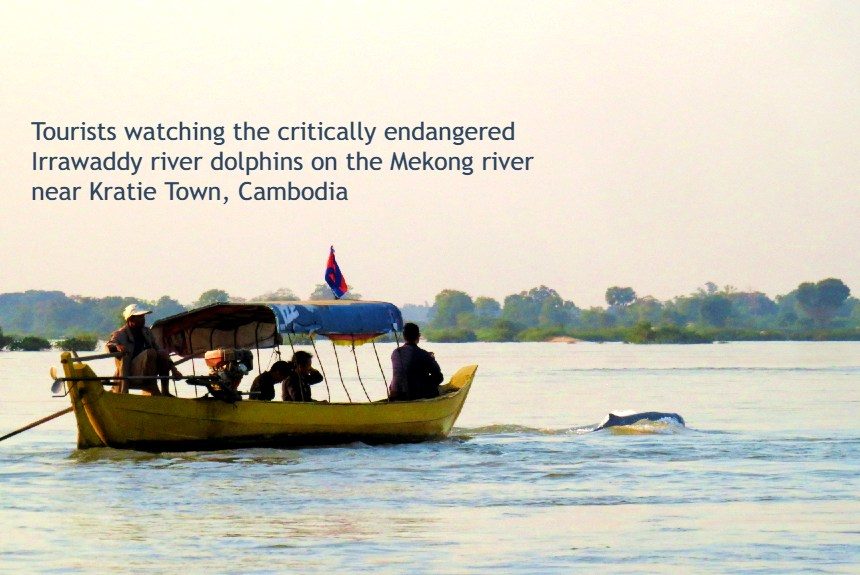Cambodia, a country in Southeast Asia, is vulnerable to climate effects. Its climate adaptation has focused primarily on agriculture.
Still, since the government has shifted to the manufacturing and services sectors, it must also protect its growing industries, such as small and medium-sized enterprises (SMEs) in tourism and hospitality.
The study examined climate change impacts on micro-businesses in Kratie Town, focusing on how they have responded and what strategies they used to adapt to climate-induced disasters.
Kratie province is located northeast of Cambodia along the Mekong River. Fisheries and agriculture are their primary industry, but their tourism industry is increasingly growing due to critically endangered Irrawaddy dolphins and the province’s incredible diversity of fish and birds that attract tourists to the area.
Its small-scale tourism and hospitality sectors are growing and becoming more critical to its economy. Before the COVID-19 pandemic, the industry employed over 1.2 million people nationwide.
Climate change has increased the frequency and intensity of climatic variability and natural hazards, which have manifested as intense rainfall, irregular timing of extreme rain, and more prolonged droughts.
Small to medium businesses in Cambodia lack access to capital and resources and operate with marginal profits, making them vulnerable and difficult to recover from disasters. Additionally, most of their structures are non-engineered buildings lacking adequate disaster management and are susceptible to mechanical crashes, utility disruptions, and telecommunication breakdowns.
In the past, the province has experienced many climate-induced disasters like floods, droughts, storms, riverbank collapse and epidemics, but among these floods, which occurred every three to five years, proved to be the most devastating of all, causing significant damages and loss to life and property.
While there are existing studies on SMEs, particularly in developing countries, they do not provide sufficient information or distinguish between SMEs’ locations, the dependence of their supply chains, and linkages among businesses, factors that can impact their coping and adaptation strategies.
The study randomly selected micro-businesses along the Mekong River, in the town, and some close to the lake, ensuring that the sampling covered businesses in a wide geographical area.
Researchers interviewed respondents to gather data on their perceptions of climate change, experience with natural disasters, impacts of climate change on their businesses, and coping and adaptation strategies in different stages: before, during, and after disasters.
Participants were also asked about their social network access, membership in business cooperation, and any official assistance that can affect their response or adaptation to catastrophes.
Data shows that respondents view climate change-induced calamities, particularly floods and storms, as affecting their business more than droughts or lightning events. Floods reduce their clients’ numbers, cut off their supply chains, and damage their shops and stocks, resulting in profit loss and stunting business growth.
However, not all businesses are affected negatively; some could profit from floods because of their coping or opportunistic strategies. For example, a porridge vendor using a boat during floods can continue selling and making more money due to reduced competition.
Businesses located outside town that are not affected by the town’s closure and others whose suppliers are outside the province and not affected by floods can continue selling and remain open for business.
The study also revealed that business owners who suffered losses and disruptions develop mental health problems.
The study finds that climate impacts and business responses vary according to the type of business. During floods, companies relying on supply chains within and outside the province were affected more than those who do not rely on suppliers and can continue to operate their business.
Hospitality businesses such as tour agents, restaurants, accommodation, and niche-food sellers had fewer clients during the flood. Tour agents were also significantly affected by the declining number of river dolphins, which have been a major tourist attraction in the Kratie province.
Overall, the study’s findings suggest that climate change impacts and micro-business responses are complex and nuanced and require an understanding of the local context. Variations in location and supply chain types also influence their response and climate adaptation strategies. The study suggests that climate adaptation measures should be time—and location-specific.
Opportunistic behaviours and climate-diversification strategies in some businesses, such as using a boat to sell goods during floods, having a budget to hire a pumping machine to pump floodwaters out of their shops, building their houses higher than flood levels, can work as an advantage over other business owners.
Finally, the study finds that national and regional policies may not have sufficiently addressed these businesses’ unique coping styles. There is also a shortage of information on SME-specific climate risks and government support to strengthen SME climate resilience, issues that the government needs to address to help SMEs shift from short-term and reactive responses to long-term and more anticipatory climate adaptation strategies.
To read the entire study, click the link below.
Source:
Ngin, C., Chhom, C., & Neef, A. (2020 April). Climate change impacts and disaster resilience among micro businesses in the tourism and hospitality sector: The case of Kratie, Cambodia. Environmental Research, Volume 186, 2020, 109557, ISSN 0013-9351, https://doi.org/10.1016/j.envres.2020.109557
PHOTO CREDIT: Andreas Neef



Leave a Reply